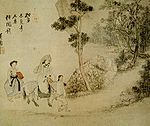
Hyewon pungsokdo
| Hyewon pungsokdo | |
| Hangul | 혜원풍속도 or 혜원풍속도첩 |
|---|---|
| Hanja | |
| Revised Romanization | Hyewon pungsokdo or Hyewon pungsokdocheop |
| McCune–Reischauer | Hyewŏn p'ungsokto or Hyewŏn p'ungsoktoch'ŏp |
Hyewon pungsokdo is an album of the genre paintings (pungsokhwa or pungsokdo) drawn by the Korean painter Shin Yunbok during the late Joseon dynasty. It was named after Shin's art name, Hyewon, and comprises 30 paintings in total.

In 1930, Jeon Hyeopil (전형필:全鎣弼), later the founder of the Gansong Art Museum, purchased it from an antique dealer in Osaka, Japan and newly mounted the album. Oh Sechang (오세창), who was a journalist and pro-independence activist, wrote the subtitles and postface for the album. Hyewon pungsokdo is designated as the 135th National Treasure of South Korea and is held in the collection of the Gansong Art Museum located in Seongbuk-gu, Seoul, South Korea.

Gallery
Entertainment (7)
| Picture | Title | Korean title | Description |
|---|---|---|---|

|
Dancing together with two swords | 쌍검대무(雙劍對舞) | Two kisaeng are performing geommu(sword dance) |

|
An amusing day in a spring field | 상춘야흥 (賞春野興) | |

|
Resounding geomungo, praiseworthy lotus | 청금상련 (廳琴賞蓮), 혹은 연당야유 (蓮塘野遊) | |

|
A boat party on the clean river | 주유청강 (舟遊淸江) | |

|
Entertainment for summering | 납량만흥 (納凉漫興) | |

|
Absorbing in the ssangyuk play | 쌍육삼매(雙六三昧) | Ssangyuk is a Korean traditional game similar to chess. |

|
Playing tuho under the forest | 임하투호(林下投壺) | Tuhoo is a Korean traditional competing game similar to darts. Players draw an arrow into a vase. |
Gibang (5)
Daily life (6)
| Picture | Title | Korean title | Description |
|---|---|---|---|

|
A scenery on Dano day | 단오풍정 (端午風情) | |

|
A story of a street by a stream | 계변가화 (溪邊街話) | |

|
Gossiping at the well at night | 정변야화 (井邊夜話) | |

|
Monks asking for alms on the street | 노상탁발 (路上托鉢) | |

|
A woman washing a laundry meets the seeker | 표모봉심 (漂母逢尋) | |

|
The dance of a shaman | 무녀신무 (巫女神舞) |
Meeting (5)
| Picture | Title | Korean title | Description |
|---|---|---|---|

|
Young people's outgoing | 연소답청 (年少踏靑) | The picture illustrates a scenery of Hanryang(man-about-town) flirting with Kisaeng on the street in spring. |

|
Leading a Kisaeng, passing on the red leaves | 휴기답풍 (携妓踏楓) | |

|
Finding the temple after hearing a bell sound. | 문종심사(聞鍾尋寺) | |

|
A Buddhist nun (biguni) greeting a gisaeng | 이승영기(尼僧迎妓) | |

|
Running into each other on the street | 노중상봉(路中相逢) |
Lovers (5)
Lust (2)
| Picture | Title | Korean title | Description |
|---|---|---|---|

|
A widow's lust in spring | 이부탐춘 (嫠婦耽春) | |

|
A beautiful tie between the tree in autumn | 삼추가연(三秋佳緣) |
See also
External links
- (in Korean) Brief information about Hyewon pungsokdo from 한국학연구소
- (in Korean) Brief information about Hyewon pungsokdo Archived 2011-05-19 at the Wayback Machine from Yahoo Korea dictionary
- (in Korean) 옛사람들의 생활모습 from 문화재청
- (in Korean) Brief information about Hyewon pungsokdo from Encyber dictionary
See what we do next...
OR
By submitting your email or phone number, you're giving mschf permission to send you email and/or recurring marketing texts. Data rates may apply. Text stop to cancel, help for help.
Success: You're subscribed now !










